Abstract
In the context of global warming and the energy crisis, a large amount of energy consumed by the construction industry has a negative impact on climate change. Green retrofitting for older multi-story houses can significantly reduce energy consumption and pollutant gas emissions. However, a comprehensive evaluation method is needed to select suitable retrofitting methods. This paper established a green renovation evaluation system, including five dimensions from the green concept, and 16 evaluation indexes. Making an old multi-story house in Shenyang the research object, 16 transformation plans were generated through orthogonal experiments. The total weights of each index were derived through entropy weighting and expert scoring, and then the best retrofit solution was selected using the improved TOPSIS method. The best retrofit solution was evaluated to reduce energy consumption by 3016.4 kWh/m2 and pollutant gas emissions by 3934.3 tons over the remaining 35 years of its life cycle while generating an economic benefit of approximately 1.58 million yuan. These study results show that the retrofitting of external walls significantly affects the building’s energy consumption; exterior windows present the most negligible impact. The photovoltaic facilities provide significant energy savings.
1. Introduction
Our country has built many multi-story houses in the early stages of urbanization to quickly accommodate the population moving from villages and towns to cities. As urbanization continually increases, urbanization in China is entering a mid- to late-stage, with the rate reaching 64.72% by 2021. Compared to new buildings, the energy used in these early multi-story houses with old construction standards is predominantly non-renewable and non-clean, which inevitably leads to low energy efficiency and significant greenhouse gas emissions, making it challenging to meet the energy savings and emission reduction requirements of current construction standards [1]. According to the International Energy Agency (IEA), the construction industry accounts for one-third of global energy consumption and nearly 40% of global greenhouse gas emissions [2]. In this context, many old buildings left behind have great potential for energy efficiency retrofitting [3,4,5]. A large proportion of these old buildings are residential buildings [6], so it is urgent to retrofit these old buildings. Understanding the current situation and retrofitting measures for old buildings is a prerequisite for successful retrofitting.
Firstly, in terms of external factors, the subjective willingness of homeowners to renovate is a critical factor that influences how the renovation proceeds. Retrofitting older homes can positively increase their property values and benefit owners by attracting external investment and improving services in the neighborhoods [7,8]. A reasonable share for retrofitting consumption can promote private sector investment, encourage homeowner contributions, relieve government funding pressures, and further promote the retrofitting of older communities [9]. Secondly, in terms of specific retrofitting methods, retrofitting homes with green roofs and walls can effectively improve building energy efficiency, improve the thermal environment of buildings, and reduce building surface temperatures and carbon emissions in urban areas [10,11,12,13,14]. Meanwhile, studies by Manso et al., and Cascone et al., have shown the high variability and potential benefits of green roofs and walls [15,16]. In addition, adding photovoltaic facilities to buildings in areas with sufficient sunlight radiation can effectively reduce non-renewable energy consumption and carbon emissions [11,17]. The importance of the building envelope in terms of energy efficiency and thermal comfort cannot be overstated. The choice of materials for walls, roofs, and windows can directly affect buildings’ energy efficiency and insulation, and commonly used building insulation materials are EPS, XPS, rock wool, perlite, etc. [18]. The thickness and type of insulation material are critical factors in the energy efficiency of roofs and facades [19,20]. Selecting suitable Low-E glass windows to replace the original non-energy-efficient windows in older homes is an effective way of saving energy [21].
Despite various retrofitting methods for older buildings, weighing up suitable technical retrofitting measures remains challenging. For example, the use of green roofs is limited by the type of roof vegetation and the climate of the area where the building is located [14,22,23]. The thermal performance of insulation materials is inversely proportional to the heat transfer coefficient, yet reducing the coefficient by simply increasing the thickness of the insulation layer or using high-performance insulation materials can unreasonably increase envelope retrofitting costs [18]. The location of insulation set in walls and roofs can influence the insulation effect and be directly related to retrofitting feasibility [24]. In this context, more and more experts and scholars have begun to focus on evaluating building retrofitting measures. In terms of building energy retrofitting measure selection, due to the limitations of the traditional analytic hierarchy process (AHP) in integrating multidimensional factors, Zheng et al. proposed an improved hierarchical analysis method in which improvements focused on the normalisation of data and the influence of subjective opinions, and case studies showed that the enhanced process simplified the complex multidimensional choice problem [25]. Li et al. proposed a multi-factor, multi-objective preference method based on orthogonal tests and entropy weights to select measures to add sunspace in typical rural houses in severe cold regions. The technique was evaluated comprehensively in four dimensions: total energy savings, incremental cost, cost-benefit ratio, and carbon emissions. The study proved that glass type and window-to-wall ratio possessed the most significant influence on sunspace [26]. Niemelä et al., from the perspective of economic and energy consumption, studied the renovation of brick apartment buildings in the Finnish region and identified the least costly renovation measures from a portfolio of over 2 billion potential renovation measures through a multi-objective optimisation (MOO) analysis using the Pareto archive NSGA-II genetic algorithm as the primary research method. The results suggested that renovation should focus on the use of renewable energy production systems [27]. As the traditional whole life cycle cost analysis (LCCA) model is heavily influenced by data, which is inherently uncertain, Ruparathna et al., proposed a new LCCA method for building energy efficiency retrofits based on fuzzy set theory. Using a case study of public buildings in the Okanagan region of Columbia, Canada, the study showed that using a fuzzy set-based approach can incorporate the uncertainty of the affiliation function into the evaluation compared to the traditional methods. Thereby predicting the lowest possible future cost caused by changes in macroeconomic factors, and improving the reliability and quality of LCCA results [28]. To solve the problem of building energy consumption and resource shortage, Lu et al., proposed an evaluation system for the economic benefits of green building energy efficiency technologies. The analytic hierarchy process (AHP) and entropy weighting methods were used to address the correlation between building technologies and economic benefits. It identified six primary evaluation indicators and 20 secondary evaluation indicators, whose empirical analysis showed that the incremental costs of green energy efficiency and renewable energy use technologies were the biggest [29].
This paper proposes an evaluation system for green technology retrofitting measures for multi-storey houses in severe cold regions based on entropy weight-TOPSIS. To ensure the scientific and rational nature of this study, five evaluation dimensions and 16 evaluation indexes are determined according to national standards and experts’ discussions. As well, 16 retrofitting solutions are generated through orthogonal experiments, while the retrofitting of each key is simulated using DesignBuilder 6.1. The total weight of each retrofitting measure was then determined using the entropy weighting method and the expert scoring method. The optimal retrofitting solution was obtained using the improved TOPSIS. Finally, the evaluation results were compared and analyzed before and after the improvement, and importance of each factor in renovating old multi-storey houses was discussed and summarized.
2. Green Retrofit Evaluation System
2.1. Establishment of the Evaluation System
The urbanisation process in China is relatively late compared to developed countries. Building renovations are still in the development stage. In contrast, research on building renovation and energy efficiency in developed countries has been relatively mature. Therefore, besides China’s Green Building Evaluation Standard, reference is made in this paper to the US Green Building Evaluation System (LEED) and Healthy Building Standard (WELL), the UK Green Building Evaluation System (BREE-AM), and the German Sustainable Building Evaluation Standard (DGNB). These standards have been used as the basis for the evaluation of residential retrofit solutions. This paper selects the five evaluation dimensions of energy saving, environmental efficiency, economic efficiency, thermal performance, and fire performance for the comprehensive evaluation of residential building renovation. After determining the evaluation dimensions, 16 evaluation indicators were chosen to form the evaluation system through discussions among 22 experts and scholars in the relevant fields of architecture, as shown in Figure 1.
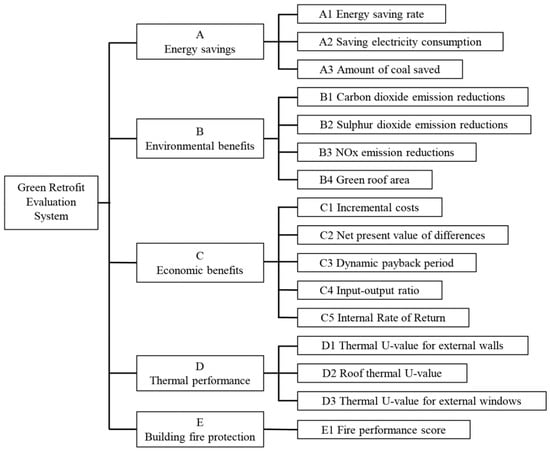
Figure 1.
Green retrofit evaluation system.
2.2. Factor Analysis of Evaluation Indicators
2.2.1. Energy Savings
The building under study is located in a severely cold region, and the primary energy consumption of the building is the cooling load generated by air conditioning in summer and the heating load generated by coal-fired central heating in winter. The energy-saving rate visually reflects the overall energy-saving effect of the building retrofit. In contrast, the electricity and coal savings reflect the savings in cooling load in summer and heating load in winter, respectively. The formulae for calculating energy efficiency, electricity, and coal savings are as follows:
where is the energy saving rate, is the energy consumption generated by the original scheme per year building, is the energy consumption caused by the retrofitted installation per year.
is the electricity-saving is the cooling load required by the original scheme, is the cooling load needed for the retrofitted building, is the electricity collected by the additional photovoltaic panels.
is the coal saving, is , Shenyang’s “14th Five-Year” urban civil heating plan proposes that the boiler hot water efficiency be calculated at 75%. Still, as boiler houses often fail to achieve the desired efficiency in actual operation because of external factors, the boiler efficiency in this paper is 65%, and the heat pipe loss is taken as 5% [30]. is the standard coal calorific value, taken as 7000 cal/g, i.e., 8.14 kWh/kg.
2.2.2. Environmental Benefits
As the primary source of energy consumption in this paper is taken from coal, the difference in CO2, SO2, and NOx emissions produced by coal combustion before and after the retrofit, is used to measure the environmental benefits. This paper uses the material balance algorithm to estimate the emissions of the three gases from coal combustion. The formula for calculating the three gases are as follows:
is the CO2 emission reduction, is the CO2 quality factor of 3.67, is the carbon content of coal taken as 70%, is the incomplete value of coal combustion as 4%, is the amount of CO2 absorbed by the roof vegetation.
is the SO2 emission reduction, is the full sulfur content of coal as 1%, is the desulphurization efficiency of coal as 40%.
is the NOx emission reduction, is the nitrogen content in coal taken as 1.5%, is the nitrogen conversion rate in coal combustion taken as 25%.
In addition to reducing greenhouse gas emissions, the use of green roofs can also bring positive environmental benefits. This paper uses the area of vegetation cover on roofs as an evaluation indicator to measure ecological benefits as well.
2.2.3. Economic Benefits
Economic efficiency is a crucial factor in determining the success of a renovation. The economic indicators selected for this paper are: investment cost, the net present value of the difference (NPV), the dynamic payback period, the return on investment (ROI), and the internal rate of return (IRR).
Due to the nature of the economic indicators, parameters need to be set before the calculation. Firstly, the life of the investment in the project is considered. The residential property selected in this paper was designed to have a useful life of 70 years at the beginning of the project, which is 42 years left. The useful life of the main building structure has been tested to be more than 35 years. Therefore, the useful life of the investment in this paper is set at 35 years.
The energy price growth rate is the second parameter. Because the energy price is increasing, the transformation benefit is mainly the electricity cost saved by air conditioning cooling in summer, the coal cost saved by collective heating in winter, and the electricity sold through PV. The price of coal is 1.5 yuan/kg, and the earnings of photovoltaic electricity are 0.97 yuan/kWh (basic tariff of 0.55 yuan and subsidy of 0.42 yuan). According to the change in electricity and coal prices in Shenyang, the adjustment value of electricity and coal prices in this paper is 5%. According to the Chinese standard, the social discount rate is affected by the bank loan interest rate, which is 8%. Combining the energy price growth rate and the social discount rate, the actual discount rate in this paper is 2.86%.
The investment cost in this paper refers to the incremental cost of greening a dwelling compared to the pre-retrofit cost (the difference between the cost of a new green retrofit dwelling and the cost of the original baseline new construction) and is calculated as follows:
where is the cost of the new green retrofitted building, and is the cost of the original baseline new building.
Net Present Value (NPV) reflects the profitability of the project investment, which is an essential indicator of the project’s economics. When the NPV > 0, it can indicate that the project is economically feasible, and NPV < 0 suggests that the project is not financially viable. The NPV calculation formula is as follows:
where is the energy savings from building renovation, and i is the discount rate.
While NPV reflects a project’s profitability, it does not measure the ability to resist the risk of short-term profitability. The dynamic payback period refers to the time from the investment’s start to the project’s cost recovery. The shorter the payback period, the more risk-resistant the project will be. The formula for calculating this is as follows:
where T is the dynamic payback period, n is the year in which the NPV is more significant than zero for the first time, is the absolute value of the cumulative value of the discounted net cash flow in the previous year, and is the net present value of this year.
The efficiency ratio is the proportion of input costs and output benefits, which reflects the efficiency ratio of the project’s output per unit of investment. Low investment and high output result in a low efficiency cost ratio. Correspondingly, increased investment and low output result in a high-efficiency cost ratio. The efficiency ratio referred to in this paper is primarily the ratio of the cost of retrofitting a home to the energy cost savings in the winter and summer. The formula is as follows:
The internal rate of return is the discount rate at which the net present value of a project equals zero over its entire operating life. The formula is as follows:
where IRR is the internal rate of return and is the annual energy saving benefit.
2.2.4. Thermal Performance
The parameter that reflects the energy efficiency of the maintenance structure is mainly the heat-transfer coefficient, the size of which is influenced by the type, thickness, and location of the insulation material. The formula is as follows:
where is the internal surface thermal resistance, is the heat transfer resistance of the envelope, and is the external surface thermal resistance, the heat transfer coefficient in W/(m2∙k).
2.2.5. Fire Protection Properties
In this renovation, the combustion performance of the insulation material is the main factor affecting the fire performance of the building. According to Building Materials and Products Burning Performance Classification building materials are divided into non-combustible, less combustible, combustible and flammable materials, according to their burning performance, corresponding to four grades A, B1, B2, and B3, respectively. As the multi-story residential building in this paper is a civil construction, according to the standards mentioned above, the external insulation material of the building should be A grade and not lower than B2 grade. In addition, the quantification of the fire performance index of the building is done using the extreme value statistical method, which translates the experts’ judgement of the fire performance into numerical intervals. This is shown in Table 1 below.

Table 1.
Fire performance scoring range.
With x experts involved in judging the fire performance of the building, each expert’s judging interval for scheme is ||, is the upper limit of the judging interval and is the lower limit of the judging interval. The final x judging breaks are obtained from an extreme value sample, and the fire performance score of each project is obtained by calculating the sample data. The formula is as follows:
2.3. Normalisation of Indicators
The indicators selected in this study are both benefit- and cost-based. Assuming that there are m evaluation objects and n evaluation indicators, the cost-type indicator is forwarded in the following way:
The overall data is then dimensionless using the vector normalization method as follows:
3. Methods
3.1. Feasibility
TOPSIS was first proposed by Hwang and Yoon [31], and after subsequent research by scholars, the idea of TOPSIS was applied to multi-objective decision problems [32,33,34,35]. The advantages are that there are no strict restrictions on data distribution and sample size requirements, and the results are intuitively geometrically meaningful. The disadvantages of TOPSIS are that the weights of each indicator need to be given in advance, and the weights have a significant impact on the experimental results. Therefore, the weights of TOPSIS need to be determined in conjunction with other subjective and objective evaluation methods. In this paper, the entropy weighting method and expert scoring are used to determine the weights of each evaluation index. The entropy weighting method uses information entropy to calculate the entropy weight of each index according to the discrete degree of the index data, and the resulting weights have objectivity.
The combination of the entropy method and TOPSIS is common. Zhang et al., proposed a model for evaluating agricultural water resource allocation schemes based on the entropy method [36]. TOPSIS established an index system containing three dimensions: economic, social, and environmental, which deeply analyzed the dynamic changes in water resource carrying capacity in the river-loop irrigation area. The results of the case study show that the model framework based on interval linear fractional planning can objectively reflect the uncertainty and complexity of agricultural water resources planning and management in the river-loop irrigation area. Chen derived four evaluation indicators by analyzing the factors affecting port operational efficiency, calculating the weights of each hand using TOPSIS and the entropy weighting method, realized the evaluation of port logistics, and proposing development suggestions regarding logistics capacity and efficiency based on the evaluation results [37]. Wu et al. constructed an evaluation index system for emergency response plans for underground stations in terms of scientific basis, completeness, operability, and flexibility. The final case study showed that operability was the most important of the four indicators [38]. Wang et al. established a new power evaluation index system from the four aspects of “source, network, load, and storage”, used TOPSIS and the entropy weighting method to reasonably assign the weights of each index to build an evaluation model, and evaluated the new power system in three typical provinces. After assessing the new power systems in three distinct areas, the evaluation results were used to propose development suggestions in four aspects: local adaptation, new energy interconnection, network and load-side construction, and power storage [39].
In summary, the entropy method and TOPSIS have been widely used in agriculture, logistics, and energy fields and have yielded some scientific results. However, more research still needs to be done to evaluate the effect of a comprehensive renovation of old houses. This paper applies the entropy weight method and the improved TOPSIS to propose a complete evaluation model for renovating old residential buildings, making the evaluation results more comprehensive and accurate.
3.2. Entropy Weighting Method to Determine Objective Weights of Indicators
The TOPSIS method requires the weights of each evaluation indicator to be given in advance. The entropy method is a method of weighing the importance of a research object, that measures the weight of each indicator in the system in terms of its degree of variability. The entropy method is carried out as follows:
An evaluation matrix is constructed with n evaluation objects and m evaluation indicators. After normalization of the original data matrix, matrix B is obtained.
The higher the entropy value, the higher the degree of disorder of the system, the less effective information it provides, and the smaller its weight; on the contrary, the lower the entropy value, the lower the degree of disorder of the system, the more practical information it provides, and the larger the weight value. The entropy value of each indicator is calculated in the following:
As the entropy method can only determine the weight of each indicator through information entropy, the objective weights derived will be distorted. The subjective weights of each indicator need to be corrected by using expert scoring. The least squares method optimizes the objective and subjective weights to produce the composite weights. The weighting and combined weight of each indicator are confirmed using the following equations:
is the objective weight obtained by the entropy method, and is the subjective weight obtained by expert scoring. In order to minimise the sum of squares of the combined weight deviations is taken as 0.5.
3.3. TOPSIS Calculates Programme Proximity
The weighting matrix is constructed as follows:
Absolute positive and negative ideal solutions are determined.
The criteria for setting positive and negative ideal solutions are as follows:
The Euclidean distance between the solution and the positive and negative ideal solution is decided by the formula below:
The proximity of each solution is calculated. The size of the proximity determines the ranking of the retrofit solutions; the larger the value is set, the better the evaluation of the retrofit solution is presented.
4. Building Green Retrofit Optimisation Analysis
4.1. Typical Building Model
Shenyang is located in a severely cold climate zone. The object of this simulation is an old multi-story house built in the 1990s with a masonry structure and no insulation on the roof and external walls. Each floor has an area of 477 m2 with a floor height of 2.9 m and six floors in total. The walls are equipped with ordinary aluminum single-pane white glass external windows on both the north and south sides, a window-to-wall ratio of 0.26, and a window sill height of 0.9 m. The heat-transfer coefficients of the external envelope are 1.035 W/(m2∙k) for the roof, 1.352 W/(m2∙k) for the external walls, and 5.78 W/(m2∙k) for the exterior windows.
The basic building parameters are designed for lighting energy consumption of 5.0 W/m2, power of household electrical equipment of 10.0 W/m2, heating cop of 0.850 and cooling cop of 2.50 in the HVAC system, room air changes of 0.7 (ac/h), personnel density of 0.05 persons/m2 and human heat dissipation of 100 W/person (factor = 0.9). Home time is set from 18:00 to 8:00 on weekdays and all day on rest days. The heating temperature of the bedroom is 20 °C, and the cooling temperature is 26 °C. Under normal circumstances, buildings in cold regions only need to consider energy consumption for winter heating. As the elderly account for many occupants in older homes, the above-mentioned basic parameters were set with the physical condition of the elderly in mind, and summer air conditioning was added for cooling. This paper establishes a typical building model based on research, as shown in Figure 2 and Figure 3, and the thermal parameters of a typical building are shown in Table 2.
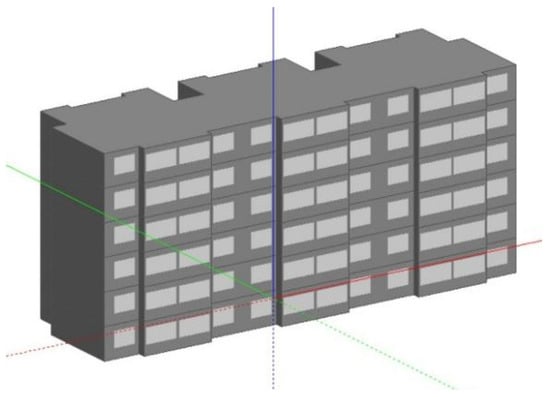
Figure 2.
South side of the model.
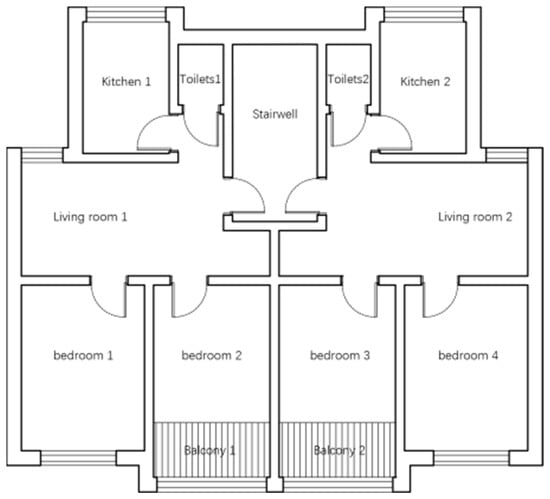
Figure 3.
Basic building unit plan.

Table 2.
Typical building thermal parameters.
4.2. Testing the Scientific Validity of a Typical Building Model
The actual annual energy consumption of the building is 573,557 kWh and 221.3 kWh/m2 calculated from the list of heating and power distribution in Shenyang. The energy consumed by central heating in winter accounts for 68% of the annual energy consumption of the building, which is in line with the energy consumption characteristics of a typical building in a cold region [40]. DesignBuilder simulates the typical building model. The simulated energy consumption is 563,987 kWh per year, with 217.6 kWh/m2. The difference between the typical model and the actual energy consumption is only 2.7%. The electricity consumption of the actual building is calculated based on the total distribution capacity. It is clear from Figure 4 that the actual electricity consumption is slightly higher than the simulated electricity consumption in the summer when there is no heating energy consumption. In summary, the typical building model established above correctly reflects the energy consumption of the actual building throughout the year.
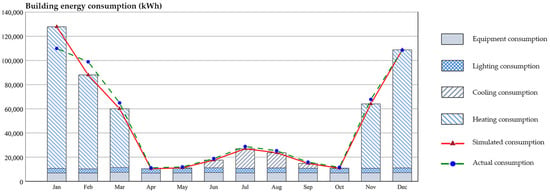
Figure 4.
Comparison of annual energy consumption in simulated and measured buildings.
4.3. Orthogonal Experimental Level Factor Analysis
In order to propose a feasible green retrofitting strategy, the green retrofitting of older homes is integrated and optimized. This paper addresses four aspects of retrofitting measures: A roof insulation, B external wall insulation, C external window type, and D photovoltaic coverage. These four aspects were used as test factors, and four levels were selected for each. Orthogonal experiments on these four retrofit measures generated 16 overall building retrofit solutions. The data analysis of each retrofit solution was then carried out by the method mentioned in Chapter 3 to find the optimal combination of levels. The orthogonal table for the green retrofit measures experiment is shown in Table 3.

Table 3.
Green retrofit measure level factor.
- Factor A: The external wall of the original building has no insulation layer. The construction level is 20 mm cement mortar, 370 mm solid clay bricks, and 20 mm cement mortar, which are from outside to inside in order. The external walls of the original building were transformed with a 70 mm thick XPS insulation board, 100 mm thick EPS insulation board, 70 mm thick polyurethane insulation board, and 100 mm thick rock wool. Insulation materials applied to the external envelope should consider the adverse effects of moisture absorption, construction compaction, etc. Regarding the insulation effect, all of which should be corrected using a correction factor (factor > 1) in calculating thermal performance. The heat-transfer coefficients of the renovated external walls are 0.325 W/(m2·k), 0.309 W/(m2·k), 0.296 W/(m2·k) and 0.349 W/(m2·k). The corresponding renovation costs are 60 yuan/m2, 55 yuan/m2, 90 yuan/m2 and 70 yuan/m2 [19]. Designbuilder’s internal price unit is the pound sterling, which requires exchange rate conversion. All subsequent exchange rates in this article are calculated using the Bank of China exchange rate at 11.00 am on 15 March 2023, i.e., 100 (GBP) = 834.62 (yuan) exchange rate.
- Factor B: The roof of the original building has no insulation layer. The construction levels from top to bottom are 35 mm lime mortar, 5 mm SBS waterproofing layer, 120 mm thick reinforced concrete slab, and 20 mm thick cement mortar. The roof of the original building was modified with 100 mm thick expanded perlite, 70 mm thick XPS insulation board, 100 mm thick phenolic foam board, and 100 mm thick glass wool board. The heat-transfer coefficients of the retrofitted roofs were 0.321 W/(m2·k), 0.305 W/(m2·k), 0.290 W/(m2·k) and 0.269 W/(m2·k) respectively, and the retrofitting costs were 70 yuan/m2, 60 yuan/ m2, 60 yuan/m2 and 50 yuan/m2.
- Factor C: The overall heat-transfer performance of a window is influenced by the type of glass, the gas interlayer, and the window frame. Moreover, the kind of glass offers the most significant impact on heat-transfer performance. Low-E glass has a better transmittance of visible light and a higher reflectance of mid- and far-infrared light than clear glass. The gas type in the gas interlayer affects the thermal insulation capacity of the window. Argon, a rare gas that can be separated from inert gases, is more expensive than filled air but has a lower heat-transfer coefficient. The combined heat-transfer coefficients for the four window options are 3.094 W/(m2·k), 1.761 W/(m2·k), 0.78 W/(m2·k), and 1.493 W/(m2·k), with retrofit costs of 500 yuan /m2, 700 yuan /m2, 2200 yuan /m2 and 1800 yuan /m2 [41].
- Factor D: Adding solar panels to buildings in areas with sufficient sunlight radiation can improve the overall energy efficiency of the building [11]. The total annual solar radiation in Shenyang is 1050~1400 kWh/m2, a low level in China. If PV achieves good experimental results in this study, it could indicate the universal applicability of PV for retrofitting old multi-story houses. The photoelectric conversion efficiency of solar panels is not only influenced by objective factors such as the light factor and its performance, but also by subjective factors such as the installation position, angle, and orientation of the photovoltaic panels. Considering the practicality of photovoltaics, the cheaper polycrystalline silicon photovoltaic panels were used in this study, with a suitably reduced photoelectric conversion efficiency of 0.15. The installation angle is taken as 36° according to the best installation angle of photovoltaic in Shenyang, and the price of a photovoltaic panel is 722 yuan/m2. Four kinds of roof transformation schemes are shown in Figure 5.
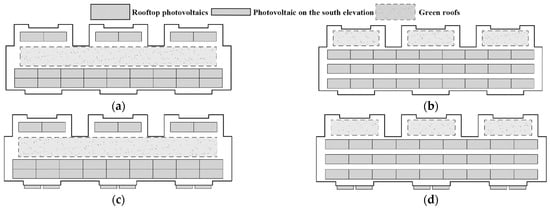 Figure 5. Photovoltaic and greenery laying method. (a) The first type of roof laying; (b) Second type of roof laying; (c) Third type of roof laying; (d) Fourth type of roof laying.
Figure 5. Photovoltaic and greenery laying method. (a) The first type of roof laying; (b) Second type of roof laying; (c) Third type of roof laying; (d) Fourth type of roof laying.
4.4. Orthogonal Experimental Design
The orthogonal experiments in this paper were only used to generate retrofitting solutions, and no ANOVA was conducted on the results of subsequent experiments. Instead, a comprehensive evaluation was driven by the five dimensions proposed in Chapter 2. The model presented in Chapter 3 was used to rank the superiority of the solutions and then analyze the evaluation results. A five-factor, four-level orthogonal table () was used. Four-factor, four-level orthogonal experiments were conducted according to the orthogonal table, generating 16 retrofit solutions. Sixteen of the retrofit solutions are shown in Table 4.

Table 4.
Sixteen transformation options generated by orthogonal experiments.
5. Analysis of Experimental Results
Using the formula mentioned in Section 3 to calculate the weights for the above five evaluation dimensions, the obtained primary weights were = 0.2027, = 0.2223, = 0.2707, = 0.1867, = 0.1176. The secondary weights for the 16 evaluation indicators under the five dimensions were = [0.06138, 0.07329, 0.06798], = [0.04806, 0.04998, 0.04008, 0.08416], = [0.05372, 0.04455, 0.0565, 0.05766, 0.05826], = [0.06163, 0.05691, 0.06750]. In descending order, the overall weighting scores are economic efficiency, environmental efficiency, energy savings, thermal performance, and fire performance, respectively. The weights of each indicator are shown in Figure 6.
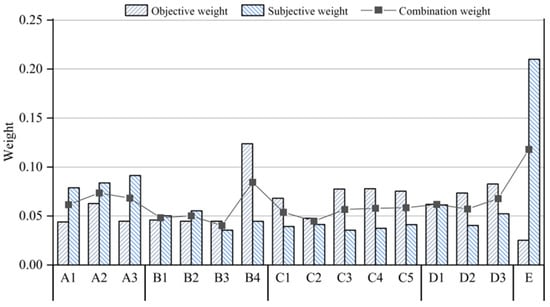
Figure 6.
Indicator weights.
Sensitivity analysis was performed on the indicators according to the highest scoring option 5, with the levels of factor variation taken as 20%, 10%, −10%, and −20%, respectively. As the sensitivity analysis was mainly used to verify the stability of the model and the degree of influence of the analyzed indicators on the evaluation results, the sensitivity coefficient was taken as the maximum value of each indicator under four levels of factors to verify the least stable situation of the model. The results showed that the maximum value of the sensitivity coefficient among the 16 evaluation indicators was only 0.31. The ranking of the best and worst solutions of the model did not change during the sensitivity test, so the model has good stability. A grey-scale correlation analysis was done on the sensitivity coefficient and the weight coefficient, and the correlation was high at 0.78, and the two trends were close to the same in Figure 7.
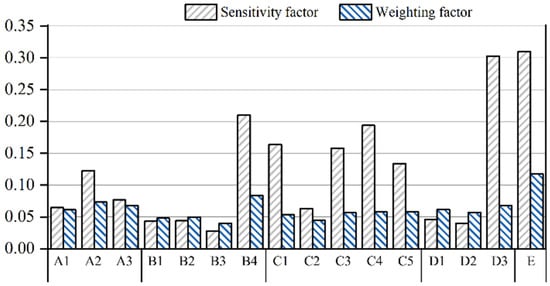
Figure 7.
Sensitivity factors and combined weights.
The results were achieved by combining Equations (1)–(13) for 16 retrofitting scenarios simulated using DesignBuilder software. The 16 retrofit options have achieved significant results in terms of energy efficiency in Figure 8, with the highest energy-saving rate being Option 8 at 56.07% and the lowest rate being Option 1 at 43.5%. However, all 16 retrofit options show a slight increase in cooling load compared to the original building. The reason for this phenomenon is that the reduction in the heat transfer coefficient of the building envelope increases the heat storage capacity of the walls and hinders the heat dissipation of the walls at night, which happens to be high percentage of air conditioning working hours at night, in line with the findings of Feng et al. [42]. The results of the single factor energy saving rate analysis are shown in Figure 9. A single factor energy saving rate analysis of the exterior envelope retrofit measures revealed single energy saving rates of 26.9%, 29.81%, 29.8%, and 28.6% for the four types of exterior walls. Roofs were 6%, 6.1%, 6.3%, and 6.5%, respectively. External windows were 7.8%, 14.1%, 18.5%, and 15.9%, respectively. Combining the heat transfer coefficients and retrofit areas of the 16 options for the external envelope, it can be concluded that in terms of energy efficiency benefits in this study, the exterior wall retrofit has the most significant impact on energy efficiency, and the roof retrofit has minor effect on energy efficiency.
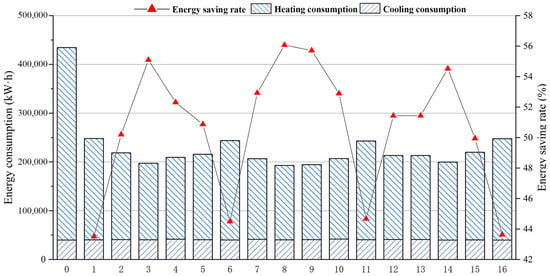
Figure 8.
Energy saving effect (without PV).
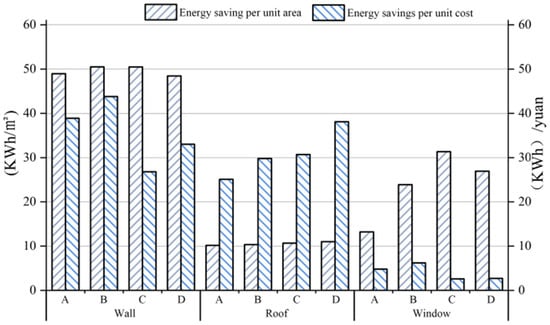
Figure 9.
Energy saving benefits of single retrofit measures.
Environmental benefits are mainly derived from building energy efficiency and green roofs, which effectively reduce the buildings’ winter heating energy consumption by enhancing the thermal insulation of the external envelope, thereby saving coal and reducing pollutant emissions. Pollutant gas emission reductions for each program are shown in Figure 10. Approximately 99% of the pollutant reductions in this study came from building energy efficiency. The installation of green roofs and the laying of photovoltaic panels require some optimization. Each square meter of green roof reduces 256 kg of CO2 over the lifetime of the building. At the same time, a green roof improves the thermal environment and effectively reduces the roof temperature in the summer. Due to the different laying methods, each square meter of photovoltaic panels in this study can bring 2396 Yuan~2645 Yuan over the whole life cycle of the building, while the benefit of laying roof photovoltaic panels is more significant than laying south elevation of the building. Based on the combined weighting, the economic benefits are weighted more heavily than the environmental benefits. Therefore, photovoltaic panels are prioritized over green roofs for roof retrofit measures in severely cold regions.
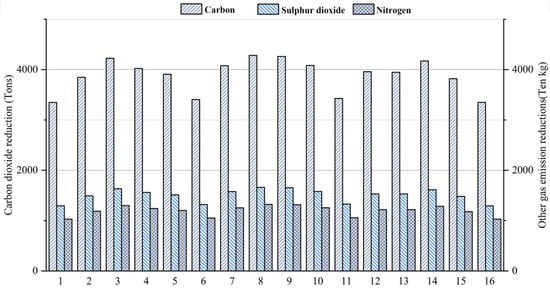
Figure 10.
Gas emissions.
Regarding economic benefits, the NPV, IRR, and ROI of the 16 retrofit options indicate that all options generate economic benefits over 35 years and are economically viable. After researching the maintenance information of the housing management department, the maintenance rate of external insulation is usually 2~3% in the housing life cycle of the Shenyang area. As calculated with a 3% maintenance rate, the actual impact on the NPV effect is only 0.4~0.8% at maximum. Therefore, the study does not include the maintenance cost of external wall and roof insulation. The study considers that the PV facility’s actual lifetime is 20 years. The PV will need to be repaired and replaced during the remaining life of the project, so the PV is included in the investment costs at twice the actual price. The effect of PV on benefits is significant. The share of PV revenue in NPV is still 38.3~72.7%. Excluding the impact of PV on economic returns, only the effect of envelope retrofitting is considered. The results of the polynomial curve fitting of the 16 retrofit options show that the highest NPV yield is achieved when the energy efficiency rate reaches 46.85%, at which point the retrofit cost is 448,808 yuan. When the energy efficiency rate exceeds 46.85%, the probability of a decrease in the return on investment per unit of retrofit increases, which may lead to a higher efficiency cost ratio and a lower internal rate of return, as well as a more extended payback period, reducing the project’s resilience. The economic results are shown in Figure 11 and Figure 12.
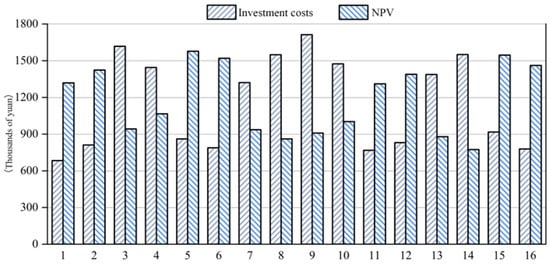
Figure 11.
NPV and investment costs.
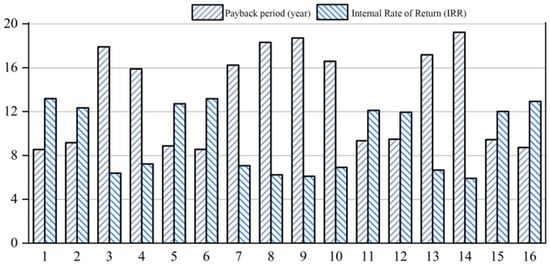
Figure 12.
Payback period and IRR.
Regarding thermal performance, the best energy savings among the three exterior envelope retrofit measures are polyurethane exterior wall insulation, glass wool roof insulation, and triple Low-E filled Arg exterior windows. The best economic performance was achieved by EPS insulation panels, glass wool insulation panels, and double-layer Low-E filled Arg exterior windows. The energy savings per unit of life-cycle retrofit cost are 43.8 kWh/Yuan, 38.1 kWh/yuan, and 6.2 kWh/yuan. The three envelope retrofit measures have the highest energy savings of 26.8 kWh/yuan~43.8 kWh/yuan for external walls. The lowest energy savings are for exterior windows at 2.7 kWh/yuan~6.2 kWh/Yuan, with the cost of retrofitting far outweighing the benefits.
Fire prevention is according to the standard Chinese GB8624-2012 [43]. This study uses the insulation material fire rating, which belongs to the A level of insulation materials: expanded perlite, glass, and rock wool insulation. The phenolic resin insulation board belongs to the B1 class. The XPS insulation board, EPS insulation board, and polyurethane insulation board belong to the B2 level. Using the Formula (13), according to the experts’ ratings, the highest score for fire performance is for the combination of rock wool and roof glass wool, and the lowest score is for the combination of XPS insulation board and roof XPS insulation. The results of the fire performance score are shown in Figure 13.

Figure 13.
Fire performance score.
Equations (14)–(26) are used to derive the final ranking of the 16 retrofitting options. Option 5 has the highest overall score, with sub-rankings being 6th for A, 6th for B, 4th for C, 10th for D, and 2nd for E. None of the six rankings are top, yet all its scores are in a better-balanced stage. This indicates that renovating old multi-story houses should not overly pursue one renovation measure to achieve significant results but rather take a holistic approach and achieve just the right renovation effect in each part. See Table 5 for ranking results.

Table 5.
Green Retrofit Evaluation Results.
6. Conclusions
Green renovations for old multi-story houses can save resources and increase economic benefits. This paper establishes 16 evaluation indicators from five dimensions and shows an evaluation system for green technology retrofitting measures for multi-story houses in extremely cold regions. An old multi-story house in Shenyang was selected as the research object, and 16 green retrofit solutions were generated using orthogonal experiments in four retrofit aspects: adding insulation to external walls, adding insulation to roofs, replacing energy-efficient exterior windows, and adding photovoltaics to roof facades. DesignBuilder software was used to simulate the building’s energy consumption throughout the year, and the feasibility of the model was verified based on the list of winter heating and district power distribution in Shenyang. Based on the generated experimental data, the total weights of the 16 indicators were established using the entropy weighting method and expert scoring form. Finally, the best retrofit solution was selected from the 16 solutions using TOPSIS.
The experimental results show that exterior wall retrofitting significantly impacts building energy efficiency in external envelope retrofitting, with the most negligible impact on the roof. In terms of environmental impact, the reduction in energy consumption of buildings is substantial, and retrofitting buildings with energy efficiency can significantly reduce air pollutant emissions over the remaining life cycle of the building. In economic terms, all 16 retrofit options provide a net return of 0.5 to 1.92 times per unit of investment. The highest benefits of retrofitting the building are from external walls, and roofs offer more benefits than windows as the area is similar to the window size. External windows are the most expensive to retrofit, and even with the selection of the best energy efficiency increases in this retrofit, double-pane Low-E filled air windows with a heat transfer coefficient of 1.761 W/(m2∙k), the energy efficiency increases only reach 6.2 (kWh/Yuan) over the remaining life of the building, Facades and roofs yield more than four times as much. Photovoltaics significantly influence economic returns. Photovoltaic revenue as a percentage of NPV ranges from 38.3% to 72.7%. Therefore, under ideal circumstances, retrofitting older multi-story dwellings should be done with as much PV as possible. The entropy weighting method gives fire performance with a lower weighting. However, the scoring results show that the importance is just lower than that of energy efficiency.
This study constructs an evaluation system of green renovation measures for old multi-story residential buildings in severe cold areas built in this study. The fire performance of the external envelope is incorporated into the evaluation system in the green retrofit of the building, and the indicators are quantified. The selection of renovation measures pays more attention to the practicality of the project and can reflect the advantages and disadvantages of each renovation measure, thus providing a reference for the renovation of old multi-story residential buildings and playing a very positive role in promoting the sustainable development of the city. The evaluation system can be further improved by adding more evaluation factors to provide a more comprehensive strategy for multi-story residential retrofitting. As the actual energy consumption of a building can be influenced by subjective human use, the simulated building energy consumption trends in this study are similar to the calculated values of actual building energy consumption with minor errors. The model can be further optimized in subsequent studies to reduce errors.
Author Contributions
Conceptualization, A.W.; Methodology, A.W. and Y.A.; Software, A.W. and S.Y.; Validation, A.W. and S.Y.; Investigation, A.W., Y.A. and S.Y.; Data curation, Y.A. and S.Y.; Writing—original draft, A.W.; Writing—review & editing, Y.A. and S.Y.; Visualization, S.Y.; Supervision, Y.A.; Project administration, Y.A.; Funding acquisition, Y.A. All authors have read and agreed to the published version of the manuscript.
Funding
This research was funded by “the Natural Science Foundation of China”, grant number (52038007; 51978418).
Institutional Review Board Statement
Not applicable.
Informed Consent Statement
Not applicable.
Data Availability Statement
The datasets used or generated in this study are available from the corresponding author of this paper upon reasonable request.
Conflicts of Interest
The authors declare no conflict of interest.
References
- Zhang, H.; Hewage, K.; Karunathilake, H.; Feng, H.; Sadiq, R. Research on policy strategies for implementing energy retrofits in the residential buildings. J. Build. Eng. 2021, 43, 103161. [Google Scholar] [CrossRef]
- Buildings. The Global Exchange for Energy Efficiency Policies, Data and Analysis. 2019. Available online: https://www.iea.org/topics/energyefficiency/buildings/ (accessed on 16 February 2023).
- Felius, L.C.; Dessen, F.; Hrynyszyn, B.D. Retrofitting towards energy-efficient homes in European cold climates: A review. Energy Effic. 2020, 13, 101–125. [Google Scholar] [CrossRef]
- Dineen, D.; Gallachóir, B.P.Ó. Exploring the range of energy savings likely from energy efficiency retrofit measures in Ireland’s residential sector. Energy 2017, 121, 126–134. [Google Scholar] [CrossRef]
- Gram-Hanssen, K.; Jensen, J.O.; Friis, F. Local strategies to promote energy retrofitting of single-family houses. Energy Effic. 2018, 11, 1955–1970. [Google Scholar] [CrossRef]
- Luo, X.; Ren, M.; Zhao, J.; Wang, J.; Ge, J.; Gao, W. Life cycle assessment for carbon emission impact analysis for the renovation of old residential area. J. Clean. Prod. 2022, 367, 132930. [Google Scholar] [CrossRef]
- Mecca, U.; Moglia, G.; Piantanida, P.; Prizzon, F.; Rebaudengo, M.; Vottari, A. How energy retrofit maintenance affects residential buildings market value? Sustainability 2020, 12, 5213. [Google Scholar] [CrossRef]
- Battisti, F.; Campo, O. A Methodology for Determining the Profitability Index of Real Estate Initiatives Involving Public–Private Partnerships. A Case Study: The Integrated Intervention Programs in Rome. Sustainability 2019, 11, 1371. [Google Scholar] [CrossRef]
- Zhuo, X.; Li, H. A Study on Cost Allocation in Renovation of Old Urban Residential Communities. Sustainability 2022, 14, 6929. [Google Scholar] [CrossRef]
- Feitosa, R.C.; Wilkinson, S.J. Attenuating heat stress through green roof and green wall retrofit. Build. Environ. 2018, 140, 11–22. [Google Scholar] [CrossRef]
- Zheng, Y.; Weng, Q. Modeling the effect of green roof systems and photovoltaic panels for building energy savings to mitigate climate change. Remote Sens. 2020, 12, 2402. [Google Scholar] [CrossRef]
- Polo-Labarrios, M.A.; Quezada-García, O.; Sánchez-Mora, H.; Escobedo-Izquierdo, M.A.; Espinosa-Paredes, G. Comparison of thermal performance between green roofs and conventional roofs. Case Stud. Therm. Eng. 2020, 21, 100697. [Google Scholar] [CrossRef]
- Shafique, M.; Xue, X.; Luo, X. An overview of carbon sequestration of green roofs in urban areas. Urban For. Urban Green. 2020, 47, 126515. [Google Scholar] [CrossRef]
- Barriuso, F.; Urbano, B. Green roofs and walls design intended to mitigate climate change in urban areas across all continent. Sustainability 2021, 13, 2245. [Google Scholar] [CrossRef]
- Manso, M.; Teotónio, I.; Silva, C.M.; Cruz, C.O. Green roof and green wall benefits and costs: A review of the quantitative evidence. Renew. Sustain. Energy Rev. 2021, 135, 110111. [Google Scholar] [CrossRef]
- Cascone, S.; Catania, F.; Gagliano, A.; Sciuto, G. A comprehensive study on green roof performance for retrofitting existing buildings. Build. Environ. 2018, 136, 227–239. [Google Scholar] [CrossRef]
- Nazari, M.A.; Rungamornrat, J.; Prokop, L.; Blazek, V.; Misak, S.; Al-Bahrani, M.; Ahmadi, M.N. An updated review on integration of solar photovoltaic modules and heat pumps towards decarbonization of buildings. Energy Sustain. Dev. 2023, 72, 230–242. [Google Scholar] [CrossRef]
- Wang, H.; Chiang, P.C.; Cai, Y.; Li, C.; Wang, X.; Chen, T.; Wei, S.; Huang, Q. Application of wall and insulation materials on green building: A review. Sustainability 2018, 10, 3331. [Google Scholar] [CrossRef]
- Aditya, L.; Mahlia, T.M.I.; Rismanchi, B.; Ng, H.M.; Hasan, M.N.; Metselaar, H.S.C.; Muraza, O.; Aditiya, H.B. A review on insulation materials for energy conservation in buildings. Renew. Sustain. Energy Rev. 2017, 73, 1352–1365. [Google Scholar] [CrossRef]
- Yang, J.; Tang, J. Influence of envelope insulation materials on building energy consumptio. Front. Energy 2017, 11, 575–581. [Google Scholar] [CrossRef]
- Urbikain, M.K. Energy efficient solutions for retrofitting a residential multi-storey building with vacuum insulation panels and low-E windows in two European climates. J. Clean. Prod. 2020, 269, 121459. [Google Scholar] [CrossRef]
- Nagase, A.; Momose, T.; Lundholm, J. Effects of native vegetation on winter thermal performance on extensive green roofs in two different areas (Tokyo and Ishikawa) in Japan. Ecol. Eng. 2022, 182, 106707. [Google Scholar] [CrossRef]
- Li, Y.; Liu, J. Green roofs in the humid subtropics: The role of environmental and design factors on stormwater retention and peak reduction. Sci. Total Environ. 2023, 858, 159710. [Google Scholar] [CrossRef]
- Ozel, M.; Pihtili, K. Optimum location and distribution of insulation layers on building walls with various orientations. Build. Environ. 2007, 42, 3051–3059. [Google Scholar] [CrossRef]
- Zheng, D.L.; Yu, L.J.; Wang, L.Z. Decision-making method for building energy efficiency retrofit measures based on an improved analytic hierarchy process. J. Renew. Sustain. Energy 2019, 11, 045101. [Google Scholar] [CrossRef]
- Li, Q.; Hu, H.; Ma, L.; Wang, Z.; Arıcı, M.; Li, D.; Luo, D.; Jia, J.; Jiang, W.; Qi, H. Evaluation of energy-saving retrofits for sunspace of rural residential buildings based on orthogonal experiment and entropy weight method. Energy Sustain. Dev. 2022, 70, 569–580. [Google Scholar] [CrossRef]
- Niemelä, T.; Kosonen, R.; Jokisalo, J. Cost-effectiveness of energy performance renovation measures in Finnish brick apartment buildings. Energy Build. 2017, 137, 60–75. [Google Scholar] [CrossRef]
- Ruparathna, R.; Hewage, K.; Sadiq, R. Economic evaluation of building energy retrofits: A fuzzy based approach. Energy Build. 2017, 139, 395–406. [Google Scholar] [CrossRef]
- Lu, H.; Sheng, X.; Du, F. Economic benefit evaluation system of green building energy saving building technology based on entropy weight method. Processes 2022, 10, 382. [Google Scholar] [CrossRef]
- Dong, K.; Tan, H.; Xu, X.; Wang, X.; Li, Y. Technical characteristics and development direction of industrial boilers in China. Clean Coal Technol. 2019, 25, 1–6. [Google Scholar]
- Hwang, C.L.; Yoon, K. Multiple attribute decision making: Methods and applications: A state-of-the-art survey. Eur. J. Oper. Res. 1981. [Google Scholar] [CrossRef]
- Lai, Y.J.; Liu, T.Y.; Hwang, C.L. Topsis for MODM. Eur. J. Oper. Res. 1994, 76, 486–500. [Google Scholar] [CrossRef]
- Chen, C.T. Extensions of the TOPSIS for group decision-making under fuzzy environment. Fuzzy Sets Syst. 2000, 114, 1–9. [Google Scholar] [CrossRef]
- Abo-Sinna, M.A.; Amer, A.H. Extensions of TOPSIS for multi-objective large-scale nonlinear programming problems. Appl. Math. Comput. 2005, 162, 243–256. [Google Scholar] [CrossRef]
- Jahanshahloo, G.R.; Lotfi, F.H.; Izadikhah, M. An algorithmic method to extend TOPSIS for decision-making problems with interval data. Appl. Math. Comput. 2006, 175, 1375–1384. [Google Scholar] [CrossRef]
- Zhang, Y.; Yang, P. Agricultural Water Optimal Allocation Using Minimum Cross-Entropy and Entropy-Weight-Based TOPSIS Method in Hetao Irrigation District, Northwest China. Agriculture 2022, 12, 853. [Google Scholar] [CrossRef]
- Chen, Z. Port logistics function evaluation model based on entropy weight TOPSIS method. Discret. Dyn. Nat. Soc. 2022, 2022, 5006900. [Google Scholar] [CrossRef]
- Wu, H.; Wang, J.W.; Liu, S.; Yang, T. Research on decision-making of emergency plan for waterlogging disaster in subway station project based on linguistic intuitionistic fuzzy set and TOPSIS. Math. Biosci. Eng. 2020, 17, 4825–4851. [Google Scholar] [CrossRef]
- Liu, Y.; Wang, Y.; Li, T.; Ma, R.; Xu, k.; Xu, W. Evaluation of New Power System Based on Entropy Weight-TOPSIS Method. Math. Probl. Eng. 2022, 2022, 7669139. [Google Scholar] [CrossRef]
- GB/T 36040-2018; Specification for the Electrical Configuration of Residential Communities. China Quality Inspection Press: Beijing, China, 2018; Volume 6, pp. 3–4.
- Ministry of Housing and Urban-Rural Development of the People’s Republic of China. Housing and Urban-Rural Development Institute of Standards and Norms, Cost Indices of Doors, Windows, Waterproof Engineering and Ground Source Heat Pump Engineering; China Planning Press: Beijing, China, 2018. [Google Scholar]
- Feng, J.; Lian, Z.; Huang, S.; Ye, M. The influence of heat transmission coefficient of office building on air-conditioning load. Sichuan Build. Sci. 2010, 36, 312–315+324. [Google Scholar]
- GB8624-2012; Classification for Burning Behavior of Building Materials and Products. Standards Press of China: Beijing, China, 2013.
Disclaimer/Publisher’s Note: The statements, opinions and data contained in all publications are solely those of the individual author(s) and contributor(s) and not of MDPI and/or the editor(s). MDPI and/or the editor(s) disclaim responsibility for any injury to people or property resulting from any ideas, methods, instructions or products referred to in the content. |
© 2023 by the authors. Licensee MDPI, Basel, Switzerland. This article is an open access article distributed under the terms and conditions of the Creative Commons Attribution (CC BY) license (https://creativecommons.org/licenses/by/4.0/).